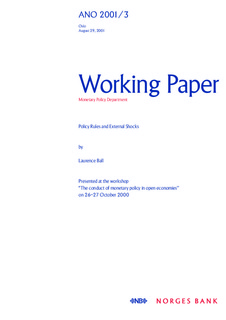| dc.contributor.author | Ball, Laurence | |
| dc.date.accessioned | 2018-05-22T11:50:20Z | |
| dc.date.available | 2018-05-22T11:50:20Z | |
| dc.date.issued | 2001 | |
| dc.identifier.isbn | 82-7553-179-9 | |
| dc.identifier.issn | 0801-2504 | |
| dc.identifier.uri | http://hdl.handle.net/11250/2498708 | |
| dc.description | Presented at the workshop ‘’The conduct of monetary policy in open economies’’ on 26–27 October 2000 | nb_NO |
| dc.description.abstract | The decade since 1990 has been a period of innovation in monetary policy. Around the world, many countries have adopted inflation targeting as their basic policy framework. Different countries have tried different techniques for achieving inflation targets, such as different choices of policy instruments. Most central banks use a short-term interest rate as their instrument, but some have experimented with “Monetary Conditions Indices” based on both interest rates and exchange rates. A rapidly-growing literature discusses the merits of different approaches to policy. | nb_NO |
| dc.language.iso | eng | nb_NO |
| dc.publisher | Norges Bank | nb_NO |
| dc.relation.ispartofseries | Working Papers;3/2001 | |
| dc.rights | Attribution-NonCommercial-NoDerivatives 4.0 Internasjonal | * |
| dc.rights.uri | http://creativecommons.org/licenses/by-nc-nd/4.0/deed.no | * |
| dc.subject | monetary policy rules | nb_NO |
| dc.subject | monetary conditions index | nb_NO |
| dc.subject | exchange rates | nb_NO |
| dc.title | Policy Rules and External Shocks | nb_NO |
| dc.type | Working paper | nb_NO |
| dc.description.version | updatedVersion | nb_NO |
| dc.subject.nsi | VDP::Samfunnsvitenskap: 200::Økonomi: 210::Samfunnsøkonomi: 212 | nb_NO |
| dc.source.pagenumber | 20 | nb_NO |

